Tropicana Field and the Oakland Coliseum are universally regarded as MLB’s two worst ballparks. I think that’s accurate. There’s no getting around the inadequacy of these structures both aesthetically and functionally, as these are the only two MLB stadiums that genuinely warrant replacement.
The Trop’s flaws have been extensively documented. As MLB’s only stationary dome, it takes the crown as baseball’s ugliest ballpark. With artificial turf, a drab interior aesthetic with no natural sunlight, and exterior materials that evoke a Walmart distribution warehouse, Tropicana Field feels more mausoleum than ballpark. It’s not particularly functional, with fairly narrow concourses closed from the field, old seats, outdated videoboards, and of course, the infamous ceiling catwalks. And it’s located in the wrong place, a difficult drive for fans in Tampa and most of the metro area.
All of that being said, here’s the thing about Tropicana Field: they try.
Given the limitations of the structure, the Rays have put a lot of time and money into making the amenities and overall fan experience otherwise respectable in the last 15 years. It was also retrofitted as baseball-only facility in 1998, so the sightlines are decent.
Now, it’s true this piece would have resonated a bit more a few years ago – the wonderful Ted Williams Museum has shuttered and closing the upper deck is a net negative, among other things. But compared to the multipurpose Oakland Coliseum, Tropicana Field has substantive redeeming qualities that make it worth a visit. Here are some of my favorite qualities of Tropicana Field:
Vibrant Local Scene
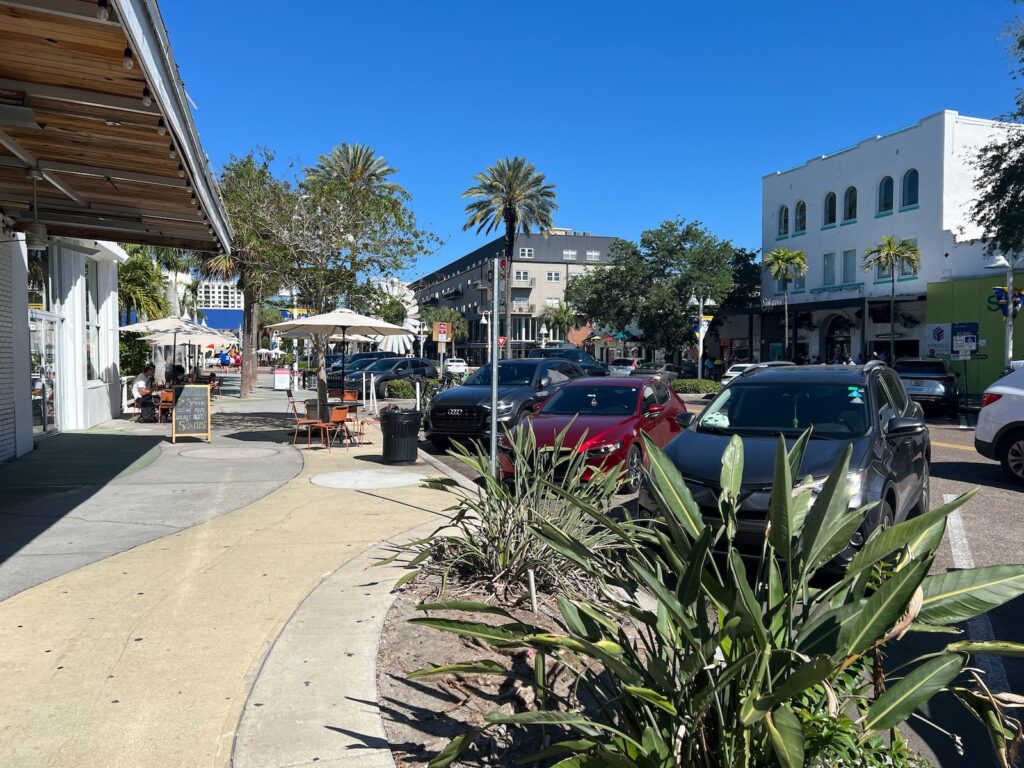
Getting to Tropicana Field is a pain. For the vast majority of Tampa Bay residents, it’s far too remotely situated in St. Petersburg, exacerbated by the excruciating traffic across the bridges. But once you’re there, the Trop’s surrounding neighborhood is loaded with fun bars, restaurants, and other attractions.
This isn’t apparent at first glance, as Tropicana Field was conceived of as a classic “parking lot stadium.” But once you go beyond those parking lots a minute walk to the Northeast, St. Petersburg’s emerging Edge District down Central Avenue is one of baseball’s better local scenes. Berg’s Sports Bar is the staple, but you have a little bit of everything from dive bars and trendy cocktail lounges to cafes and artisan shops. The lack of a solid hotel nearby option is my only qualm.
The similarly charming Downtown St. Petersburg is about a 12-minute walk away, notable for the Salvador Dalí Museum. Note the sidewalk plaques celebrating St. Petersburg’s spring training history throughout the Edge District and Downtown as well.
Centerfield Rotunda

Transitioning from the Florida sunshine to the dreary Tropicana Field in the spring should come with a sudden onset depression warning. Aesthetically, it’s that bad. But the light and airy rotunda in center field – Tropicana Field’s “front door” – helps ease that transition.
Added during the 1998 renovations, the eight-story rotunda topped with transparent glass was inspired by Ebbets Field’s rotunda. A baseball diamond is painted on the floor, and the walls are adorned with posters of Rays’ legends. It’s the only design feature on this list.
Roof Lights
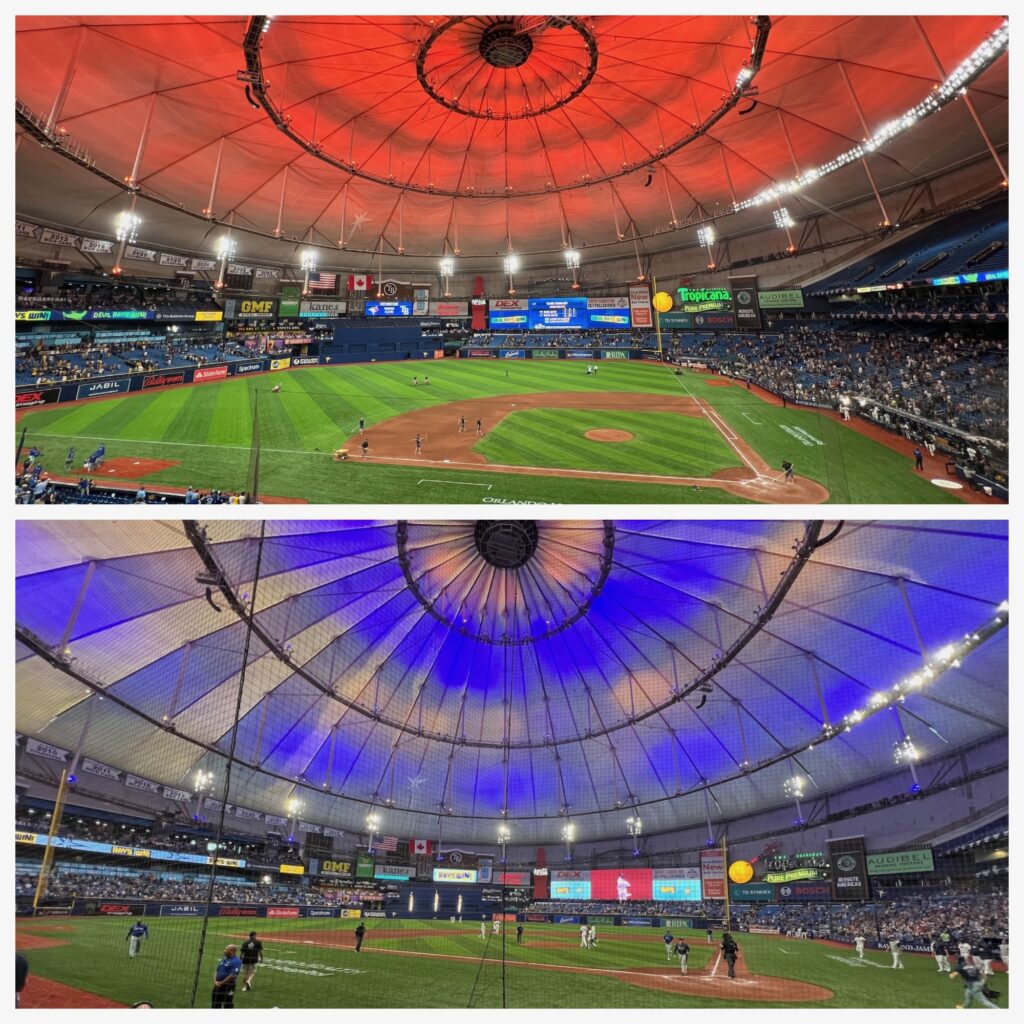
Hey, if you have a dark, enclosed stationary dome with no natural light inside, and LED dome light feature is certainly a nice touch. Upgraded before the 2019 season, Tropicana Field’s LED light installation can emit a variety of hues, most notably orange and blue. The roof lights are turned on at times before and after games, as well as sometimes between innings and to celebrate home runs. Nothing else like it in MLB.
Solid Food Selection and Quality
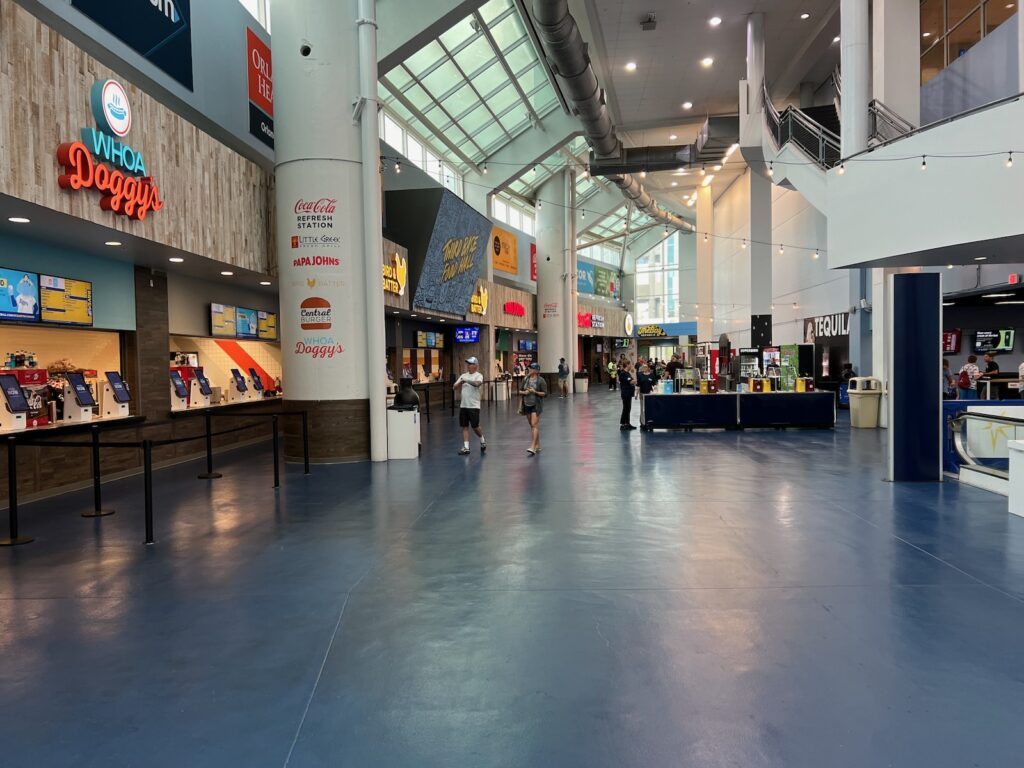
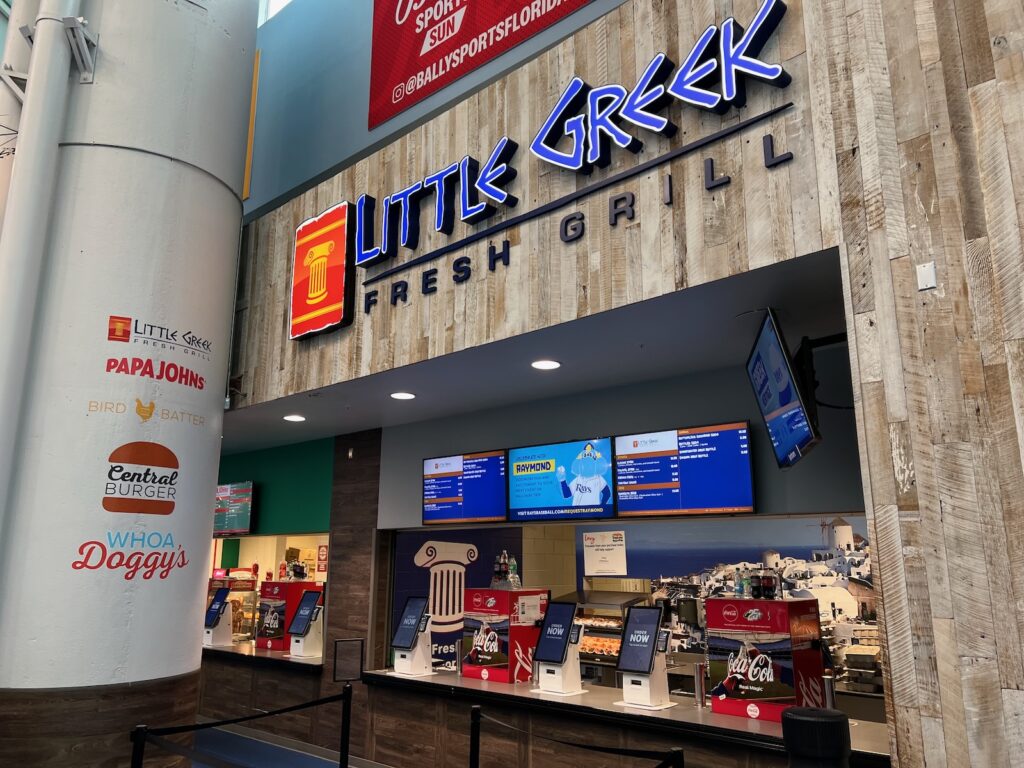
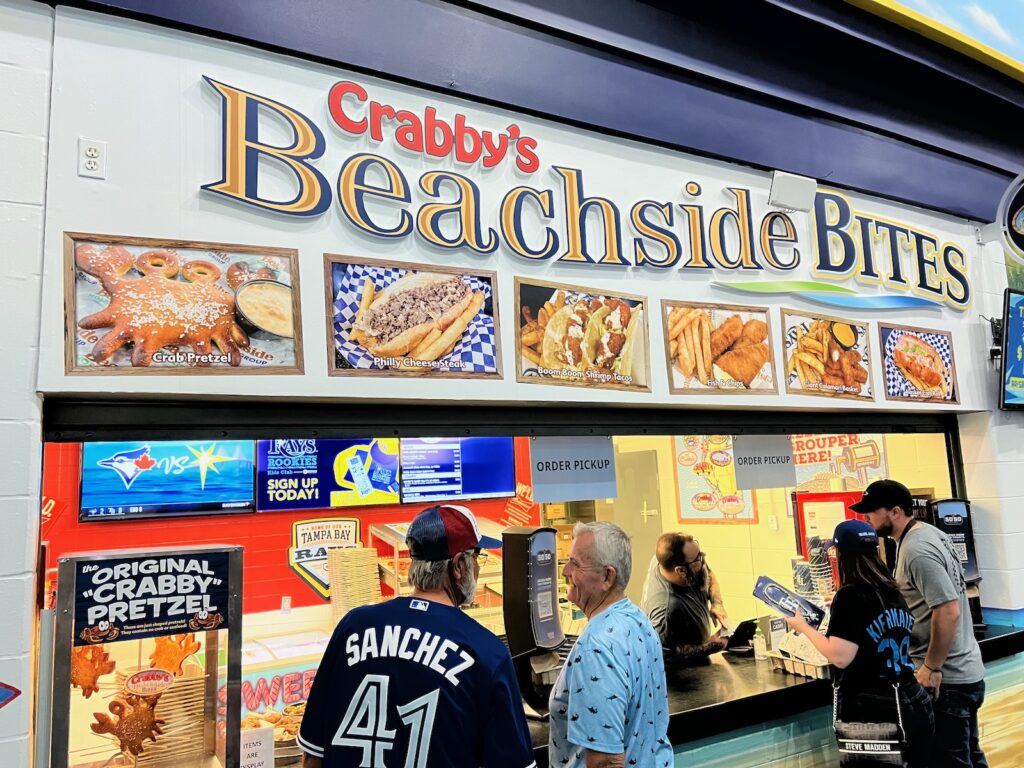
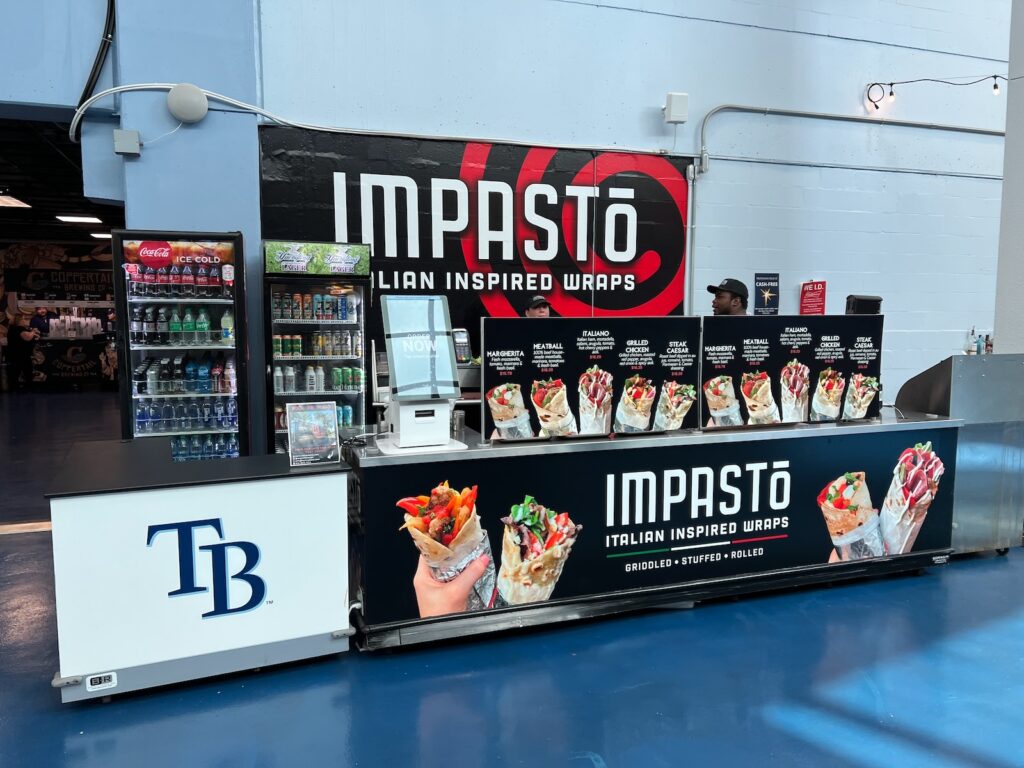
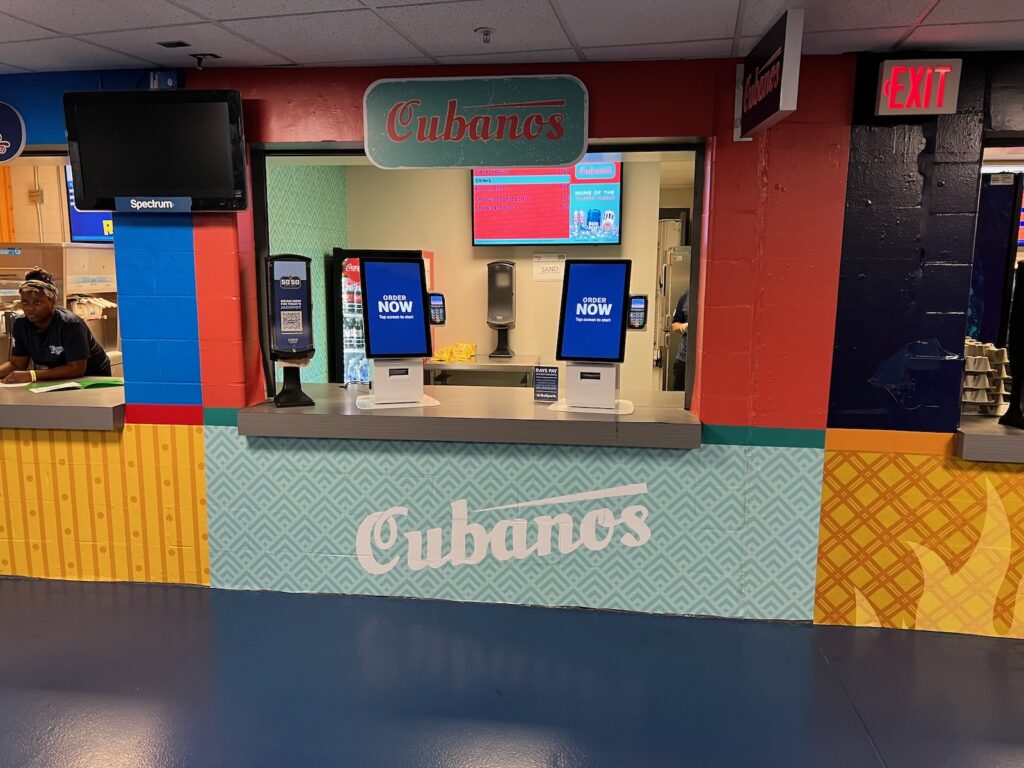
Tropicana Field’s food is quite underrated. I can’t vouch for the quality of everything, but the variety of grub offered is in the top half of MLB parks. Local restaurants and food trucks (note the pre-game free samples) have good representation at the concession stands, usually a sign of decent quality.
Mostly concentrated in the large food courts on the first and third base sides, along with the center field street, notable specialty grub or yummy items include: gyros from Little Greek, Italian wraps from Impasto, Italian sandwiches from Fiamma, seafood from Crabby’s Beachside Bites, sushi from Pacific Counter, Cuban sandwiches from Cubanos, Central Burger sliders, specialty salads, and short rib grilled cheese.
On the downside, the local craft beer selection isn’t as good as I remember.
Rays Touch Tank
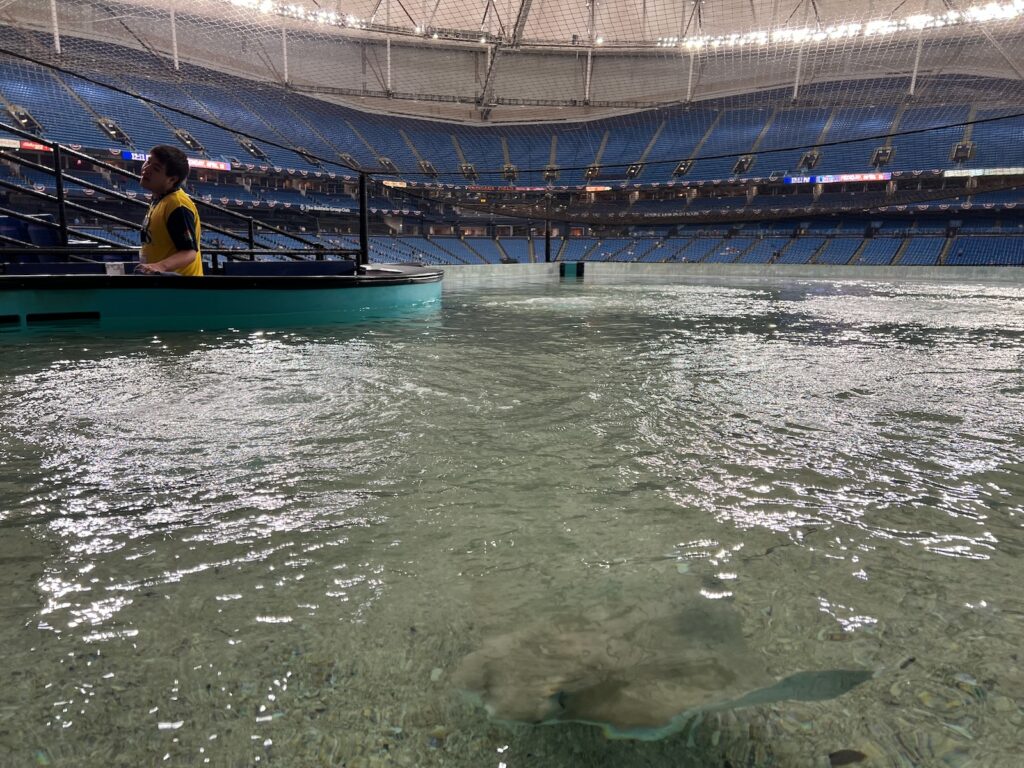

The first of its kind in a sports venue, the Rays Touch Tank is certainly Tropicana Field’s coolest amenity.
In a partnership with the Florida Aquarium, the 35-foot, 10,000-gallon tank is filled with cownose and southern stingrays from the waters of Tampa Bay. Fans can touch the stingrays (and sometimes, feed them), which is not only novel but significantly less frightening than a comparable space the Detroit Tigers’ ballpark. A nearby staff member provides educational information. Always a thrill for the kids.
Celebration of Tampa Bay Rays’ History


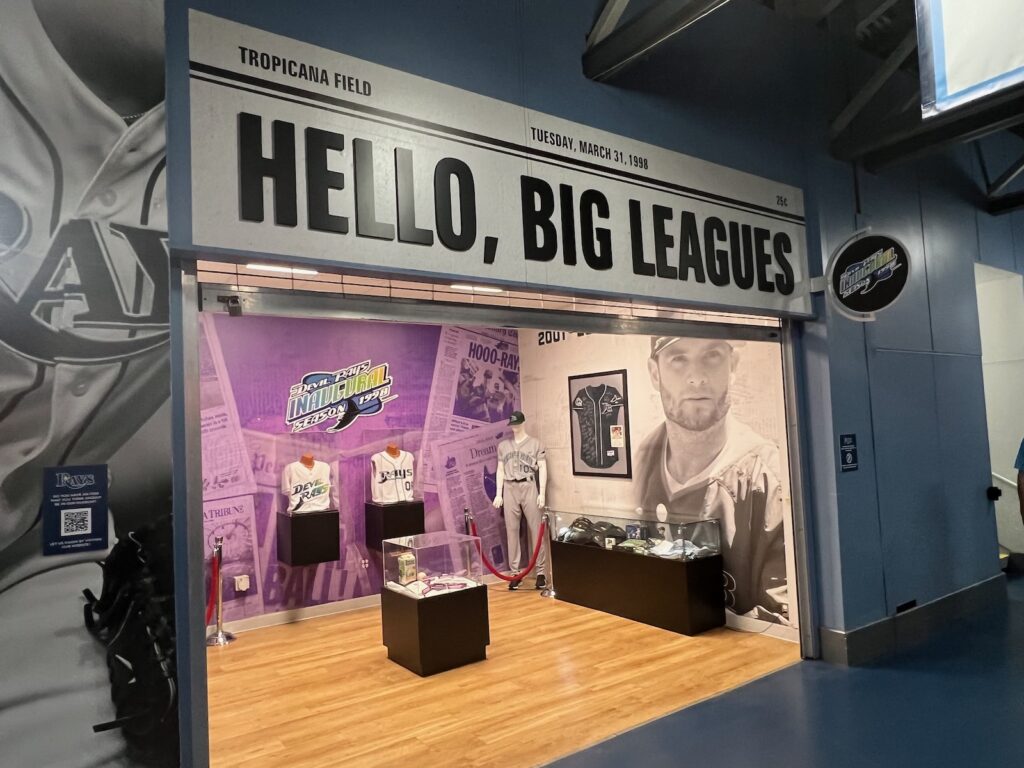
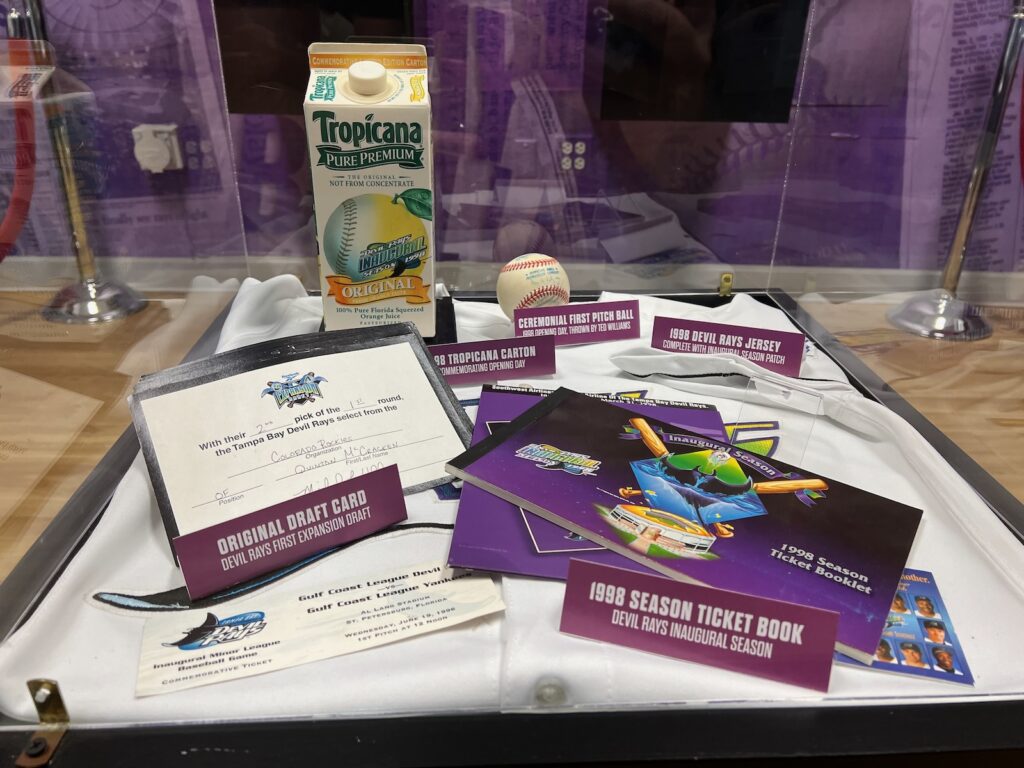
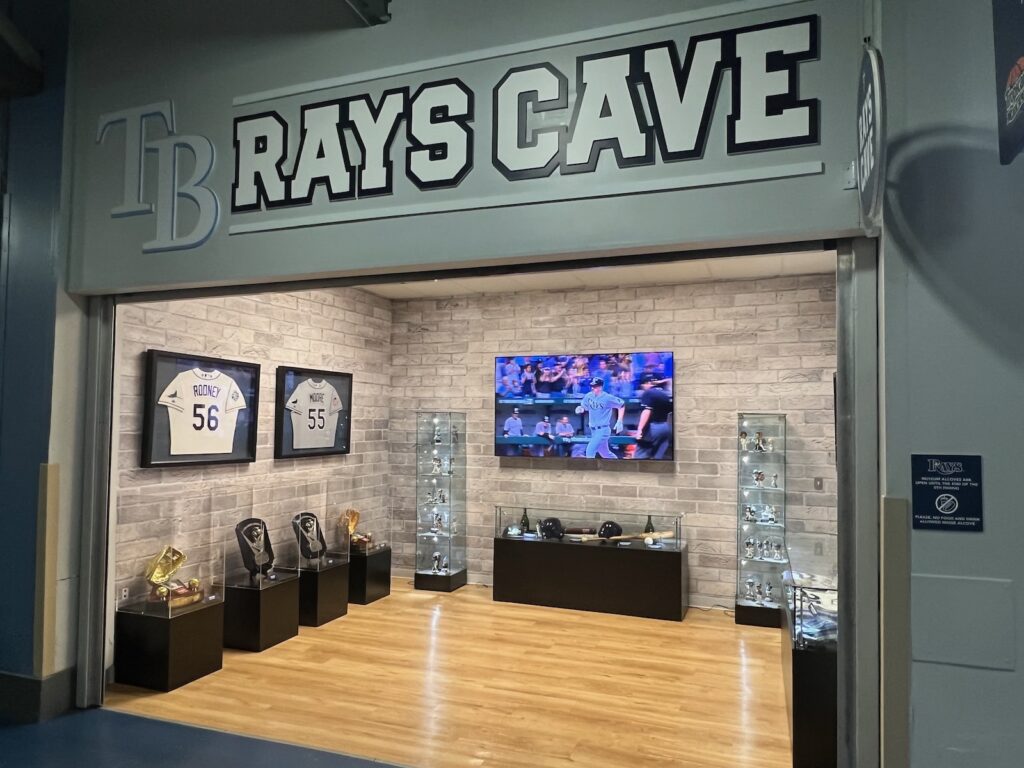
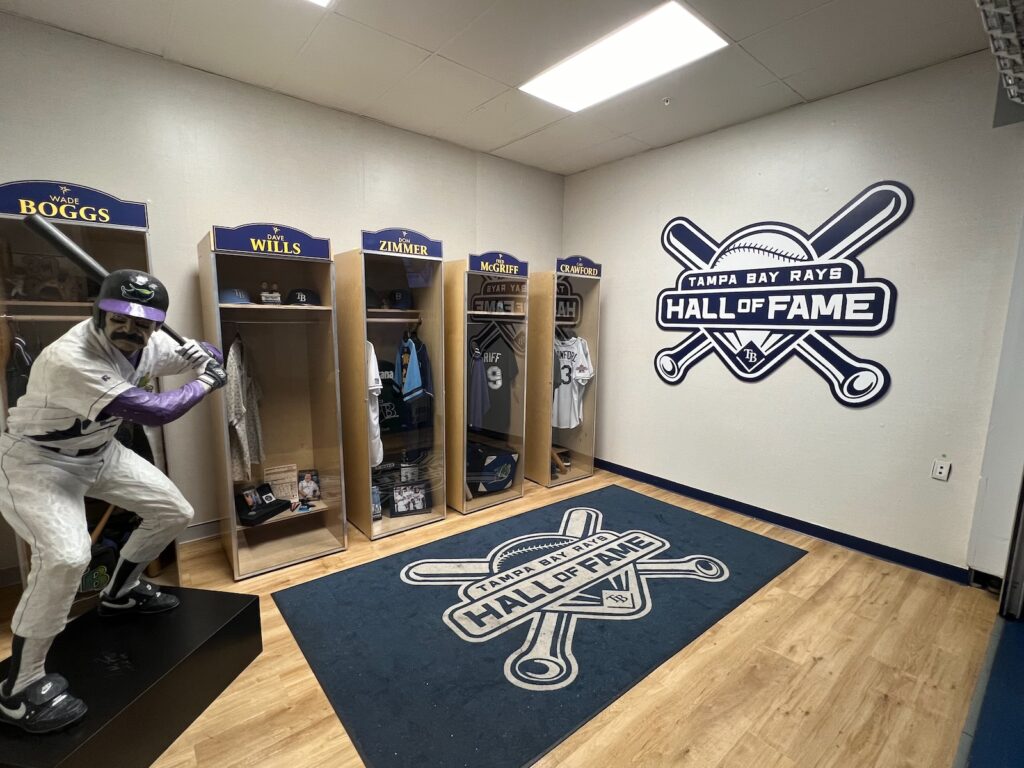
The vast majority of MLB ballparks honor the team’s history through museums or dedicated memorabilia displays. Think Monument Park in New York, Monument Garden in Atlanta, the decade bats in Detroit, and dedicated team museums in Cincinnati, Kansas City, and others.
Given the team’s short history and the Trop’s impending closure, the Rays could have phoned it in here. Yet they don’t. Throughout the left field concourse, four enclaves showcase Rays’ memorabilia. The following are the exhibits:
1) “Chasing Pennants” showcases the American League Championship years, recounting the 2008 team that went from “worst-to-first.” Plus, stuff from 2020 like Randy Arozarena’s game-used bat.
2) “Hello, Big Leagues” presents the original Devil Rays uniforms and equipment, narrating the franchise’s transformation in appearance. It also features items from the inaugural game and season.
3) “Rays Cave” celebrates Joe Maddon, Don Zimmer, Ben Zobrist, David Price, and others by showcasing their awards, All-Star Game uniforms, and road trip attire.
4) “Hall of Fame Alcove” commemorates the Hall of Fame class inducted during the Rays’ 25th anniversary season, including Wade Boggs, Don Zimmer, and Carl Crawford. Their lockers display some of their most iconic memorabilia.
It doesn’t compare to the best MLB ballpark historical displays, but I really appreciate the effort.
Last year, the Rays also added statues of Evan Longoria celebrating his iconic walk-off home run in Game 162 of the 2011 season, along with Akinori Iwamura recording the final out in the 2008 ALCS to win the pennant. Also note the 162 Landing party area celebrating Longoria’s walk-off on the most historic final regular season day in MLB history.
Ballpark and Rec
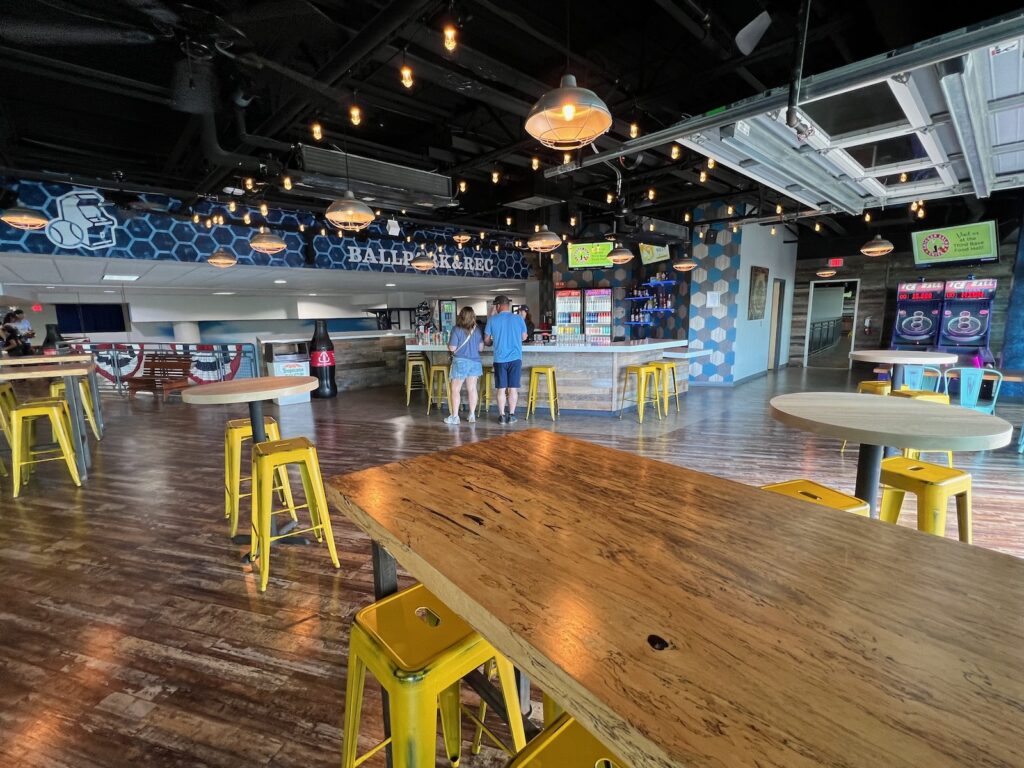
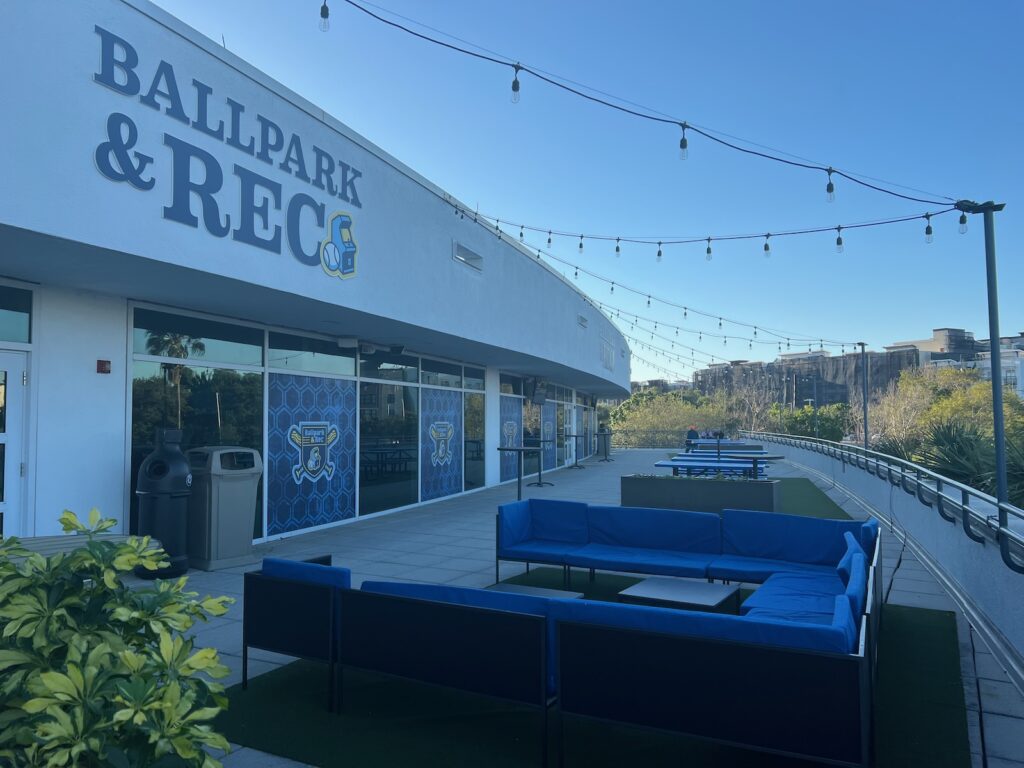
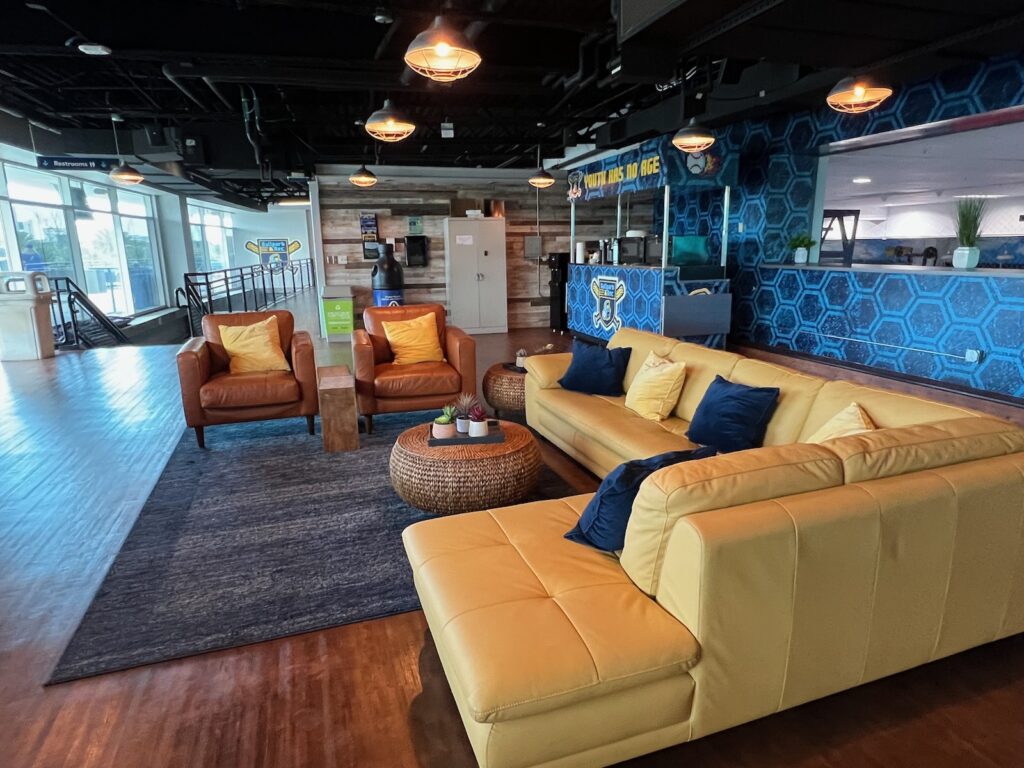
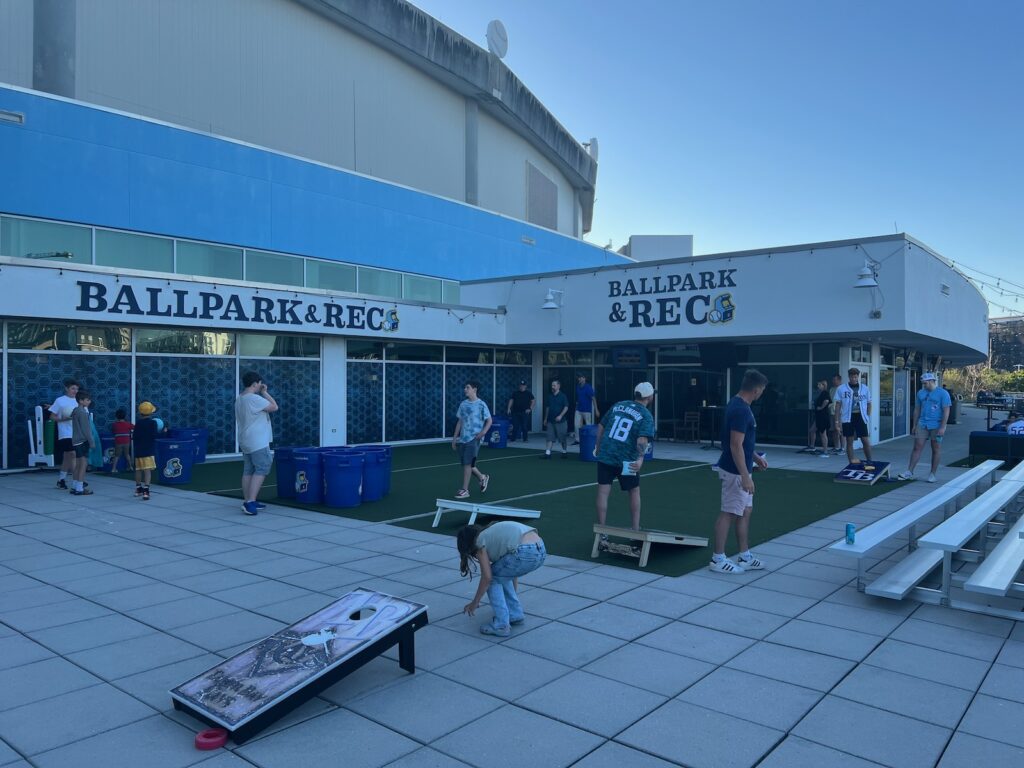
In-park restaurants, bars, and social gathering areas that allow fans to “hang out” before the game are a crucial element of the 21st century stadium experience, and Tropicana Field has a pretty nice one.
Replacing both an old cigar bar (RIP!) and a worn eatery, the massive, bi-level Ballpark and Rec is the place to be before a Rays game.
The lower level off the center field concourse offers a full-service bar and restaurant with live pre-game music. The upper level features a unique indoor/outdoor experience. Inside, we have another full-service bar, pre-game drink specials, arcade games, and lounge areas. Outside, you will find additional lounge areas and yard games like cornhole, pong, and jumbo-sized Jenga. Ballpark and Rec is also open after the game.
Perhaps MLB’s Best Gameday Staff
This is anecdotal, but I’ve found the ballpark staff to be absolutely fantastic across multiple revisits over the years. I have some theories. For one, maybe they’re just not used to folks like myself taking so many photos of their unsightly facility. Seeing someone take interest in the actual park is unusual.
But from talking to the higher ups, I’ve learned that everyone is trained to go above and beyond, because the team knows Tropicana Field sucks, so they want to make the experience as nice as possible. These are some of my favorite people in MLB.
It’s Unique

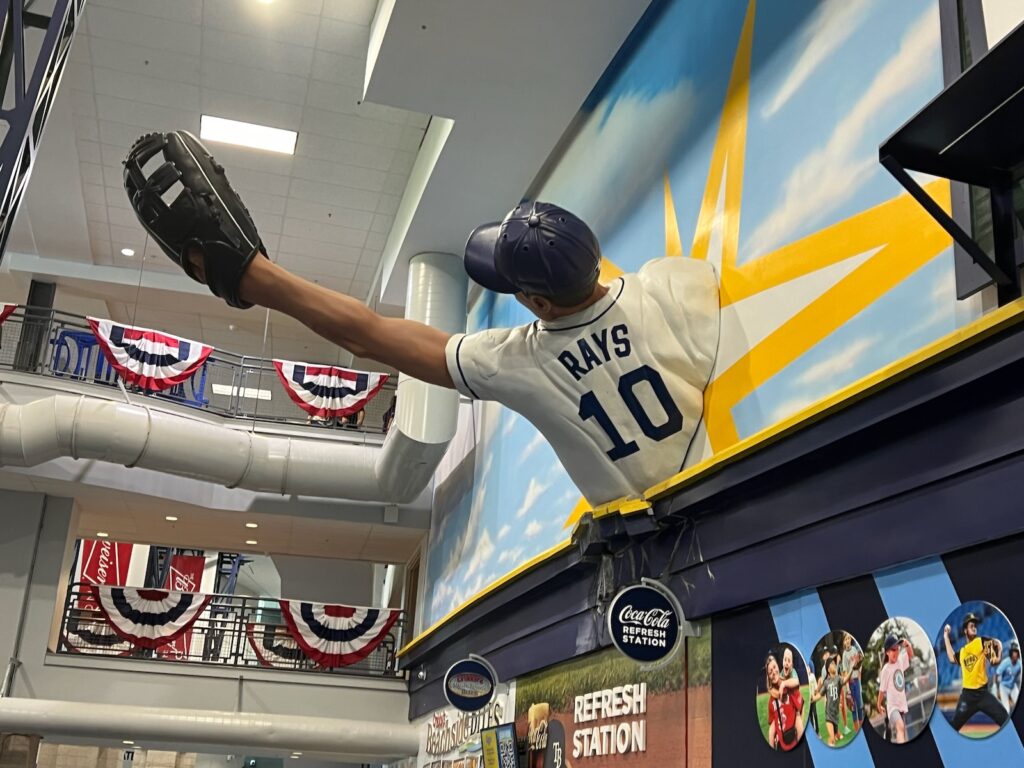
Very little about Tropicana Field is pretty. But it’s one of a kind, the good and the bad.
Between the surreal design elements and the just plain weird aspects of the fan experience, consider:
- The slanted roof, designed to reduce the interior volume to reduce cooling costs and better protect the stadium from hurricanes.
- The aforementioned roof lights.
- The catwalks.
- The outfield concrete walls peppered with luminating advertisements, including the gaudy Tropicana orange fruit.
- The bright blue concourse aesthetic.
- The random picnic party areas on the field.
- The hidden concourse areas that look like a hospital wing. Or an abandoned subway terminal.
- That bizarre half-a-player statue protruding from the wall (here’s another angle!)
- The random entertainment like the arcade games and the juggler on the centerfield concourse
It’s all kind of charming. The retro-classic parks of the 90s and 2000s largely imitated Camden Yards, which itself was an emulation of the early-20th-century jewel box ballparks. While not indistinguishable from each other like the cookie cutters, the retro ballparks ended up being somewhat formulaic. They all have quirks in the spirit of the jewel box parks, but those quirks are contrived.
Tropicana Field’s oddities and awkward design elements, in their own way, have an endearing quality, because they’re real, not a product of the P.R. department in an artificial attempt to be quirky. The retro parks also became kind of forgettable in their similarity. There’s nothing else like Tropicana Field.
It’s Cheap (at least on the secondary market)
Since the Rays closed the upper deck, artificial scarcity has driven up face value ticket prices. But on the secondary market, some of baseball’s best deals can be found.
Tickets in the $30 range can be found around the infield, including those behind the dugouts. Mezzanine tickets, usually the domain of “club levels,” are priced in the $10s and $20s. Rays Club tickets at the top of the lower bowl on the first base side, which include an all-inclusive buffet, beer, wine, and non-alcoholic drinks, drop into the $70s, where you can easily eat and drink your ticket price!
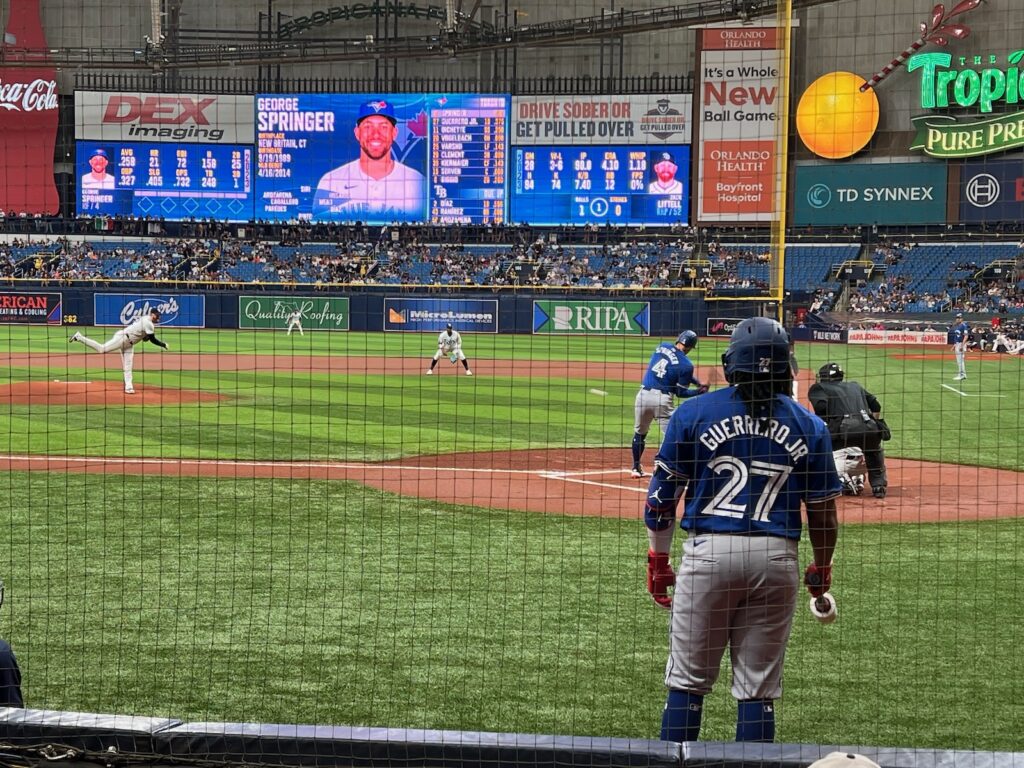
Overall, I always enjoy revisiting Tropicana Field. It’s situated in a fun neighborhood, has decent concession options, has a few unique fan-friendly amenities, and is one of a kind.
Tropicana Field is still one of MLB’s two “bad” ballparks. Indeed, I rank it #29/30. But it’s not that bad, as I’d separate it from the Oakland Coliseum which has traditionally had almost no redeeming qualities. Yes, the current Tropicana Field experience is lipstick on a pig, but the Oakland Coliseum is just a pig.
Unless noted otherwise, all images, including the featured image and images in the mini-photo galleries, are by Cole Shoemaker/Ballpark Ratings.